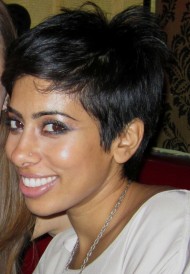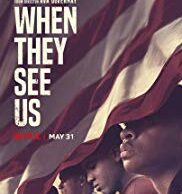Walking the Tightrope: Good Indian Girls, Race, and Bad Sexuality
By Chaya Babu
I was a few weeks into my freshman year at Duke when my sister, a senior at the time, said to me, “Indian girls who date black guys are sluts.” Just like that.
We were sitting in her car in the circular driveway behind my dorm. The night was warm and wet in the late North Carolina summer. I had just told her about the budding flirtation with a boy from Memphis who lived across the grassy quad. I would spy him coming back from class and get the jitters. He asked me to help him study Spanish. I got excited just talking about it. And her sisterly response? Indian girls who date black guys are sluts.
I think I was already mildly aware of this idea. It had lurked in the periphery of my consciousness in high school because of the way my family looked suspiciously upon my adolescent tryst with a lanky, dark-skinned boy from a neighboring town and even my interest at a young age in hip hop music. They didn’t say anything, but they didn’t have to. The unspoken messages about how they viewed blackness and sexuality and the intersection of these two things – and how I was attaching myself to it – were successfully transmitted. And lately, at 30 years old, I wonder if I’m still working through them somewhere deep beneath the surface as I finally try to reclaim and redefine this part of my identity as my own.
If I’m honest with myself about the big picture, I actually think this all started before boys could even be blamed. Maybe when I was around 11 or 12. I remember being in a hotel room with my sister and a few children of my parents’ friends, the only other Indians I knew and whom I saw maybe twice a year. One girl in the room decided to turn the group’s attention to my facial features and how un-Indian they were: the tip of my nose was a little rounder than my sister’s; my lips were full, fat, and sat prominently on my face. Everyone turned to do their own individual nitpicking before agreeing that, yes, Chaya does look a little weird.
“You know…” she said, squinting her eyes and thinking, calculating, “You almost look black.”
Everyone laughed. I was confused. Why was that funny? Sometimes people looked “less Indian” than other people. Big deal. But the others seemed to understand something about the final comment that I missed. The way they regarded me after drawing that collective conclusion was poignant – there was mockery but also something stronger: a disdainful othering. A “you are like that, and that’s bad.”
The concepts of good and bad within Indian society, particularly when it comes to women and girls, are built around virtue. Ahem, chastity. This is widely known to be the case in India itself, where women’s lives and choices are largely restricted and controlled supposedly for their own safety. But in reality, these protections are meant to hinder their sexual freedom, not ensure their overall wellbeing. Similarly, the Indian American community and its values are not far off from this culture. The women are expected to be, and are viewed as, virginal and sexually submissive. The silence around female sexuality – everything from the onset of puberty to reproductive health to attitudes about sexual activity – is common in Indian American homes. And then young people take this with them into their personal and social lives, carrying stigmas about sex and judgment for those who break the rules. In this way, I was able to make the connection, even if only in the periphery of my adolescent mind, about what it was about me that was wrong. The curves of my face, my boisterous personality – versus many other Indian girls’ reserved studiousness – and my avid obsession with making mix tapes off of Hot 97: to other Indians, these things indicated something unrespectable and, indirectly, sexual about me. And it was like a stain that spread over the years.
Simultaneously, growing up in an affluent WASPy enclave of Westchester County and a school system where the only ethnic minorities aside from myself and a few Asian Americans filtered in from another district only after eighth grade, I experienced the opposite around my day-to-day peers. It wasn’t just that I was not seen as attractive (because that is subjective overall, color aside); it was that I was wholly invisible during that high school process of exploring sex and romance. My friends flirted, dated, and hooked up casually and significantly. Guys came to me at parties and in the cafeteria to talk about who in my clique they were currently hoping to pursue. I listened to boy banter about which girls were hot; the only time I ever heard a non-white female being discussed was when someone had fooled around with a black girl and then subsequently made fun of her vagina. Publicly. Because it was brown.
Women of color were mostly unseen as partner options. And if we landed in the purview somehow, it was, at best, to be mentioned as perhaps pretty and then quickly dismissed (you know, the “Wow, you’re pretty for an Indian girl” line) or, at worst, to be ridiculed for our ugliness. This may sound extreme, but it’s the reality I lived. I undoubtedly stood out in this context – ashy knees in the winter, unruly mane of thick, black hair in a sea of pale midriffs and near-ubiquitous gold or platinum highlights – but I was also invisible. And that external gaze is powerful: the invisibility desexualized me.
Here, enter black boys. Two, specifically, over four years of high school – not exactly like I rotated through all of the Harlem Wizards or something. I was brown; they were the other brown people around. It wasn’t really that farfetched. But what’s more memorable and noteworthy than these actual relationships is what people on the outside believed about them, something that follows me to this day after a fierce drawn-out battle in adulthood with my family over a boyfriend, also black, whom I was with for six years and nearly married. Half a lifetime of words about big dicks, super-sperm, promiscuity, sexual prowess, and insatiability, etc. etc. etc. haunt me. Not exactly the stuff nice little Indian girls are made of.
I silently accepted the loud assertions that “Chaya loves black guys!” put on me by the white boys who ruled the Briarcliff social world. At 17, I didn’t know how to have a voice about the exoticization, and implicit oversexualization, of me and my choices. So instead, I kept quiet and clung to the good Indian girl in me: while others gave blowjobs in bushes at house parties (yes, these were the sexual norms I was around as a teenager), I mostly steered clear of the bases past second. I earned the name “Chastity Chaya” because of my behavior, or lack thereof, and we all shared an understanding that the label was endearingly humorous but also infantilizing.
Then, a few years later and in a new place, when my sister told me that Indian girls who date black guys are sluts, which I sadly learned was indeed the popular perception, I remained a virgin, almost sitting out college hookup culture altogether. In the segregated campus social dynamics, I had what a male friend called a “reverse reputation” in one circle, while the Indians still looked upon me as a bad seed. Something dirty. Because I hung out with the Alphas and went to “black parties” on the weekends. One Indian classmate even asked me once, “Do your parents know about this?” As if I had gotten caught snorting heroine at a brothel. And when it came to white people, I think I continued to feel overlooked, but even this was changing. Instances such as being told that a friend’s boyfriend, a Jewish guy, mentioned to her that I come off as “very sexual and should be careful” occurred in higher frequency. I was unaware of this at the time, but in not embracing what would have actually been healthy, human sexual experiences, I was doing the balancing act. I was donning the mask of asexuality that Melissa Harris-Perry refers to in her book Sister Citizen when she says that black women throughout American history have had to conceal their true identities and desires in order to fight vicious stereotypes about their hypersexuality.
After all these years, I’m single for the first time not in a collective setting of a school or university. I’ve finally come to see clearly the odd dichotomy I’ve been navigating of being seen as prudish and puerile and, alternately, overly sensual and almost dangerous because of the ways I step outside of that virtuous Indian woman trope, even if only in the way I speak, carry myself, and dress. I’ve found that I almost always worry that a guy is reading me in one of these two extreme ways. And I do an exhausting dance of guessing which one it is so I can counter it with the appropriate behavior. Only recently did it occur to me that this is not something I can control, that it’s not my fault. That realization in itself is helping me shut out the noise to slowly find the in-between – and with that, my authentic self.
_____________________________________________
 Chaya Babu is a journalist from New York with experience covering race and women’s issues in Chicago and Mumbai. She has a master’s from the Medill School of Journalism, and her past work has appeared in The Wall Street Journal, Huffington Post, and the India-based publications OPEN Magazine, The Sunday Guardian, and The Alternative. You can check her out blogging about life as an Indian-American woman at www.fobbysnob.tumblr.com.
Chaya Babu is a journalist from New York with experience covering race and women’s issues in Chicago and Mumbai. She has a master’s from the Medill School of Journalism, and her past work has appeared in The Wall Street Journal, Huffington Post, and the India-based publications OPEN Magazine, The Sunday Guardian, and The Alternative. You can check her out blogging about life as an Indian-American woman at www.fobbysnob.tumblr.com.




Pingback: dirty words, filthy mind, profane body–reclaiming language & god | Waiting to Be
Pingback: dirty words, filthy mind, profane body–reclaiming language & god | Waiting to Be
Pingback: dirty words, filthy mind, profane body–reclaiming language & god | Waiting to Be
Pingback: dirty words, filthy mind, profane body–reclaiming language & god | Waiting to Be